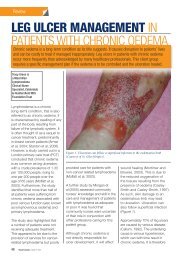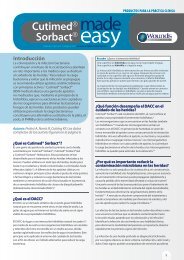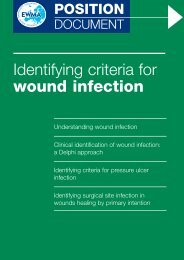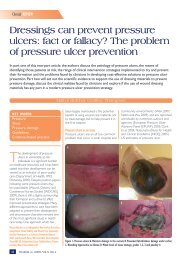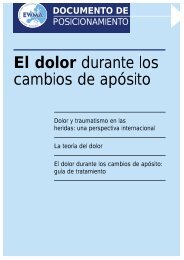Clinical PRACTICE DEVELOPMENTTable 1.Method for Doppler peripheral arterial pressure measurement and Ankle Brachial Pressure Index (ABPI)calculation (Vowden et al, 1996)Explain the procedure, reassure the patient and ensure that he/she is lying flat and iscomfortable, relaxed and adequately rested with no pressure on the proximal vessels1. Measure the brachial systolic blood pressure:8Place an appropriately sized cuff around the upper arm8Ensure that the equipment and the arm are at heart level8Locate the brachial pulse and apply ultrasound contact gel8Angle the Doppler probe at 45degrees and move the probe to obtainthe best signal8Inflate the cuff until the signal is abolished then deflate the cuff slowly andrecord the pressure at which the signal returns, being careful not to movethe probe from the line of the artery8Repeat the procedure for the other arm8Use the higher of the two values as the best non-invasive estimate ofcentral systolic pressure and use this figure to calculate the anklebrachial pressure index (ABPI)2. Measure the ankle systolic pressure:8Place an appropriately sized cuff around the ankle immediately above themalleoli having first protected any ulcer or fragile skin that may be present8Examine the foot, locating the dorsalis pedis pulse and apply contact gel8Continue as for the brachial pressure, recording this pressure in the sameway again with limb and sphygmomanometer at heart level8Repeat this for the posterior tibial and if required the peroneal andanterior tibial arteries8Use the highest reading obtained to calculate the ABPI for that leg8Repeat for the other leg8Calculate the ABPI for each leg using the formula below or look upthe ABPI using a reference chartABPI = Highest pressure recorded at the ankle for that leg/Highest brachial pressure obtained for both armsABPI normally > 1.0ABPI < 0.92 indicates arterial diseaseABPI > 0.5 and < 0.9 can be associated with claudication and if symptoms warrant,a patient should be referred for further assessmentABPI 1.00, with an ABPI of 0.92generally being regarded as the cut-offfor normal.Carter (1969) emphasisedthat meticulous attention to detailis necessary to obtain valid andreproducible measurements. A lackof awareness of the limitations ofthe ABPI and a failure to utilise allthe information obtained can lead toconflicting results and misinterpretationof the data. These issues have beenreviewed by Vowden and Vowden(2001). For example, even though thecalculation method may give an ABPIof 1.00 it does not mean that arterialdisease is not present. A pressuredifference of 15mmHg or morebetween vessels at the ankle indicatesproximal disease in the vessel with thelower pressure. This could be relevantwhen assessing the potential risk ofbandage pressure damage or assessingcardiovascular risk.Bianchi (2005) has highlighted anumber of concerns over performingDoppler evaluations. These are:8Perceived problems in locating footpulses which should be overcome bytraining and basic knowledgeof anatomy8Cited difficulties associated withthe probe angle and maintainingthe position of the probe overthe artery. These issues have beenlargely overcome by recent designmodifications to the Doppler whichnow incorporates a wider probehead and a moulded surface whichhelps users to maintain the correctprobe angle. For simple pressuremeasurement, probe angle is not asimportant as the signal itself, and isnot subject to analysis. However, theprobe angle is relevant when moredetailed analysis of the signal, suchas waveform analysis, is required.Probe angle will also affect thesound characteristics and thereforea good technique will aid the overallassessment process although it mayhave little effect on simple pressuremeasurement8All techniques measuring systolicpressure require the patient to beappropriately positioned with thelimb to be assessed at heart level.This is no different if Doppler orpulse oximetry is used to measuresystolic pressure; in both casesthe patient needs to be supine.Experience, and with it increasingskill, overcomes problems relatedto limb laterality cited by Fowkeset al (1988)8Extremities of both hyper- andhypotension impact directly on14 <strong>Wounds</strong> <strong>UK</strong>, 2006,Vol 2, No 1
Clinical PRACTICE DEVELOPMENTthe accuracy of non-invasivemeasurements of peripheralsystolic pressure and will effect theaccuracy of both ABPI and LOIcalculations (Carser, 2001). Theimpact of this is likely to be small,however, particularly in the rangeABPI 0.8 to 1.0.8Assessment of patients with severearterial disease may be difficultas detection of blood flow, andtherefore pressure, is difficultno matter which measurementtechnique is used. Patients withan ABPI of 0.8 or higher should,however, have a good strongsignal which should be easilyobtained. Patients with leg ulcersand pressures below these levelsshould be referred to a specialistcentre in line with guidelines (RoyalCollege of Nursing [RCN], 1998;Scottish Intercollegiate GuidelinesNetwork [SIGN], 1998). Variationsof up to10% in ABPI are of somerelevance in research studies orborderline cases but in clinicalpractice and in epidemiologicalstudies, a single assessment isacceptable (Fowkes et al, 1988)8The presence of oedema andlymphoedema can compromisepressure measurements, irrespectiveof the technique used. To minimisethis, the correct cuff size selection isrequired. Use of alternative Dopplerprobes, such as a 5 rather than an 8MHz probe will improve the depthof ultrasound penetration and aidvessel detection.The authors agree that Dopplerskills need to be enhanced. Thistechnique is necessary, not just forthe management of patients withvenous leg ulceration but also as partof the assessment of any patient withpotential peripheral vascular disease.Indeed it has been shown that thereis a direct relationship between ABPIand cardiovascular risk (Ogren et al,1993) indicating that this test shouldbe actively applied as part of cardiacassessment in primary care.The concerns raised by Bianchi(2005) are, therefore, mainly relatedto operative skill and experiencethat should be overcome by trainingand practice. Rather than lookingfor an alternative to this method ofassessment, healthcare professionalsshould increase their use of thehand-held Doppler to allow morewidespread application of this screeningtest for peripheral vascular disease.The authors agree thatDoppler skills need to beenhanced. This technique isnecessary, not just for themanagement of patientswith venous leg ulcerationbut also as part of theassessment of any patientwith potential peripheralvascular disease.Pulse oximetry and LOIBianchi (2005) has reviewed thedevelopment of pulse oximetry fromthe early reports of the measurementof oxygen consumption usingspectroscopy in 1874. Much of theinitial work using pulse oximetrycentred on its use in anaesthetics andemergency medicine. More recentlyit has been recognised that the pulseoximeter can detect tissue perfusion(Joyce et al, 1990), peripheral arterialdisease by reactive hyperaemic testing,(Couse et al, 1994) and arterialocclusion pressure.Jawahar et al (1997) found thatpulse oximetry was not a goodmethod of detecting early peripheralarterial disease, which raises questionsover the use of the technique inthe venous leg ulcer population.Johansson et al (2002) found that toesystolic pressures could be recordedaccurately, however, this is a differenttechnique for LOI to that describedby Bianchi (2005). Johansson’spaper confirmed the advantage oftoe systolic pressure measurement,whether by photoplethysmography,strain gauge, oximetry or Doppler,in the assessment of some patientswith diabetes. True toe systolicpressure has been related to footulcer healing in the patient withdiabetes (Carter, 1993).Bianchi has suggested that thismethod of assessing peripheral arterialdisease by measuring systolic pressureusing a pulse oximetry probe may beof value in assessing patient suitabilityfor compression therapy for lower limbvenous ulceration (Bianchi et al, 2000;Bianchi and Douglas, 2002; Bianchi,2005).In the technique described in theLOI, the blood pressure cuff is placedaround the ankle in the same positionas used for Doppler ankle systolicpressure measurement (Bianchi, 2005).As the pressure recorded is at thesite of the cuff and not the site of theprobe, this technique measures theankle systolic pressure and not the toepressure as implied by the calculationmethods. As such it suffers from thesame limitations as ABPI calculationsand has the same potential forinaccuracy in the presence of vascularcalcification and medial sclerosis. Theseinaccuracies may actually be increasedKey Points8 Vascular assessment is not justa number but an integrationof clinical signs, symptoms andinvestigation results.8 Doppler arterial assessmentand ABPI provide moreinformation on vascular statusthan LOI.8 LOI is subject to many ofthe difficulties and potentialinaccuracies caused byvascular disease that applyto ABPI assessment andis not a replacement for acomprehensive Dopplerassessment of the peripheralcirculation.8 Demand within primary carefor general cardiovascularand peripheral vascular riskassessment will increase use ofDoppler and, therefore, skill inABPI measurement.<strong>Wounds</strong> <strong>UK</strong>, 2006,Vol 2, No 115






